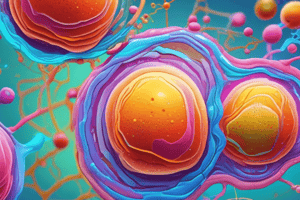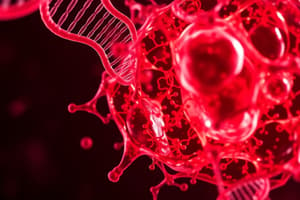Podcast
Questions and Answers
What is the primary function of ribosomes in a cell?
What is the primary function of ribosomes in a cell?
- To transport nutrients
- To synthesize proteins (correct)
- To provide structural support to the cell
- To generate energy
Which type of ribosomes produces proteins that will be excreted from the cell?
Which type of ribosomes produces proteins that will be excreted from the cell?
- Cytosolic ribosomes
- Rough endoplasmic reticulum ribosomes (correct)
- Smooth endoplasmic reticulum ribosomes
- Free-floating ribosomes
What role do microfilaments play in a cell?
What role do microfilaments play in a cell?
- They transport vesicles within the cell.
- They create a protective barrier around the cell.
- They play a significant role in muscle contraction. (correct)
- They anchor organelles in place.
What is a notable characteristic of intermediate filaments?
What is a notable characteristic of intermediate filaments?
How do microtubules assist during cell division?
How do microtubules assist during cell division?
What requires energy for movement in cells?
What requires energy for movement in cells?
Which of the following statements about cilia is correct?
Which of the following statements about cilia is correct?
What is the composition of microtubules?
What is the composition of microtubules?
What is the primary function of the nucleolus within the nucleus?
What is the primary function of the nucleolus within the nucleus?
Which layer of the nuclear envelope has ribosomes attached?
Which layer of the nuclear envelope has ribosomes attached?
What distinguishes euchromatin from heterochromatin?
What distinguishes euchromatin from heterochromatin?
What is the main role of the smooth endoplasmic reticulum?
What is the main role of the smooth endoplasmic reticulum?
Which part of the Golgi apparatus is responsible for receiving vesicles?
Which part of the Golgi apparatus is responsible for receiving vesicles?
How does rough endoplasmic reticulum aid in protein processing?
How does rough endoplasmic reticulum aid in protein processing?
What role does the nuclear envelope play in cellular function?
What role does the nuclear envelope play in cellular function?
Which of the following best describes the chromatin structure?
Which of the following best describes the chromatin structure?
What is the primary function of the Trans Golgi network?
What is the primary function of the Trans Golgi network?
Which process involves the addition of a sugar residue to a protein?
Which process involves the addition of a sugar residue to a protein?
What role does cholesterol play in the cell membrane?
What role does cholesterol play in the cell membrane?
What is the primary function of lysosomes?
What is the primary function of lysosomes?
Which enzyme is NOT typically found in peroxisomes?
Which enzyme is NOT typically found in peroxisomes?
What is the main role of mitochondria in the cell?
What is the main role of mitochondria in the cell?
How are ribosomes classified based on their location?
How are ribosomes classified based on their location?
Which of the following statements about mitochondrial DNA is true?
Which of the following statements about mitochondrial DNA is true?
What process do lysosomes participate in to recycle cellular components?
What process do lysosomes participate in to recycle cellular components?
Which type of diffusion allows for the transport of materials against their concentration gradient?
Which type of diffusion allows for the transport of materials against their concentration gradient?
Flashcards
What is the Nucleus?
What is the Nucleus?
The control center of the cell, housing DNA and responsible for crucial functions like DNA replication and transcription.
What is the Nuclear Envelope?
What is the Nuclear Envelope?
A double-layered membrane that surrounds the nucleus, regulating the passage of molecules between the nucleus and cytoplasm.
What is the Nucleolus?
What is the Nucleolus?
Small, dense region within the nucleus responsible for synthesizing ribosomal RNA (rRNA).
What is Chromatin?
What is Chromatin?
Signup and view all the flashcards
What is Euchromatin?
What is Euchromatin?
Signup and view all the flashcards
What is Heterochromatin?
What is Heterochromatin?
Signup and view all the flashcards
What is the Rough ER?
What is the Rough ER?
Signup and view all the flashcards
What is the Smooth ER?
What is the Smooth ER?
Signup and view all the flashcards
Trans Golgi
Trans Golgi
Signup and view all the flashcards
Golgi apparatus
Golgi apparatus
Signup and view all the flashcards
Cell Membrane
Cell Membrane
Signup and view all the flashcards
Lysosomes
Lysosomes
Signup and view all the flashcards
Peroxisomes
Peroxisomes
Signup and view all the flashcards
Mitochondria
Mitochondria
Signup and view all the flashcards
Ribosomes
Ribosomes
Signup and view all the flashcards
O-Type Glycosylation
O-Type Glycosylation
Signup and view all the flashcards
Phosphorylation
Phosphorylation
Signup and view all the flashcards
Passive Transport
Passive Transport
Signup and view all the flashcards
What are ribosomes and what is their function?
What are ribosomes and what is their function?
Signup and view all the flashcards
What are the different types of ribosomes and what do they produce?
What are the different types of ribosomes and what do they produce?
Signup and view all the flashcards
What is the cytoskeleton?
What is the cytoskeleton?
Signup and view all the flashcards
What are microfilaments and what are their functions?
What are microfilaments and what are their functions?
Signup and view all the flashcards
What are intermediate filaments and what are their functions?
What are intermediate filaments and what are their functions?
Signup and view all the flashcards
What are microtubules and what are their functions?
What are microtubules and what are their functions?
Signup and view all the flashcards
What are cilia and flagella and what are their functions?
What are cilia and flagella and what are their functions?
Signup and view all the flashcards
Are microtubules ATP-dependent?
Are microtubules ATP-dependent?
Signup and view all the flashcards
Study Notes
Nucleus
- The nucleus is the control center of the cell, containing DNA and responsible for crucial cellular functions like DNA replication and transcription.
- It’s surrounded by a double-layered membrane known as a nuclear envelope with an outer layer and an inner layer.
- Nuclear Envelope:
- The outer layer has ribosomes attached to it, facilitating the movement of mRNA from the nucleus to the cytoplasm.
- The inner layer has lamin proteins that help control the shape of the nuclear envelope, interact with chromatin, and play a role in cell division.
- The nuclear pores, embedded in the nuclear envelope, allow selective transport of molecules like ions, proteins, and nucleotides between the cytoplasm and nucleus.
- Nucleolus:
- Found inside the nucleus, responsible for rRNA synthesis.
- rRNA combines with proteins to form ribosomes.
- Chromatin:
- A complex of DNA and proteins, primarily histones, that forms chromosomes.
- Euchromatin: Loose, actively transcribed chromatin, often found in the center of the nucleus, facilitates gene expression and DNA replication.
- Heterochromatin: Dense, tightly packed chromatin, located near the inner nuclear membrane, less active in transcription and replication.
Endoplasmic Reticulum
- Rough ER:
- Network of interconnected membrane-bound sacs and tubules.
- Has ribosomes attached to its outer membrane.
- Involved in protein synthesis, specifically for proteins destined for lysosomes, cellular membranes, or secretion.
- Helps fold proteins and modify them by adding sugar residues (glycosylation).
- Packages proteins into vesicles for transport to the Golgi apparatus.
- Smooth ER:
- Continuous with the rough ER but lacks ribosomes.
- Primarily associated with lipid synthesis, producing fatty acids, phospholipids, and cholesterol.
- Contains enzymes like CYP450 crucial for detoxification of drugs, toxins, and alcohol via biotransformation.
- Plays a role in glucose 6-phosphate metabolism.
- Stores calcium ions, important in muscle contraction and other cellular processes.
Golgi Apparatus
- Stacks of flattened, membrane-bound compartments (cisternae).
- Plays a key role in sorting, modifying, and packaging proteins and lipids.
- Receives vesicles containing proteins and lipids from the rough ER and smooth ER.
- Cis Golgi: The receiving side of the Golgi apparatus, where vesicles enter.
- Trans Golgi: The shipping side of the Golgi apparatus, where modified proteins are packaged into new vesicles for delivery to their final destinations.
- Modifies proteins by adding sugars or other molecules, further processing them.
- Packages proteins into vesicles for transport to lysosomes, the cell membrane, or secretion.
- The Golgi apparatus is responsible for glycosylation reactions, specifically the O-type glycosylation, which involves adding a sugar residue to the oxygen component of a protein.
- The Golgi apparatus phosphorylates specific types of proteins, a process crucial for proper cell function and linked to diseases like eye cell disease.
- After glycosylation and phosphorylation, the Golgi packages molecules into vesicles.
- These vesicles transport modified proteins and lipids to their final destinations, which include lysosomes, cell membranes, and excretion out of the cell.
Cell Membrane
- The cell membrane is composed of a phospholipid bilayer, comprising a polar, hydrophilic head (phospholipid) and a non-polar, hydrophobic tail (fatty acids).
- Cholesterol is embedded within the phospholipid bilayer and controls membrane fluidity. Higher cholesterol levels decrease fluidity, while lower levels increase fluidity.
- Proteins within the cell membrane act as transporters, enzymes, and linker proteins between cells.
- The cell membrane functions as a selectively permeable barrier, allowing specific types of diffusion, including simple diffusion, facilitated diffusion, and vesicular transport.
Lysosomes
- Lysosomes are spherical organelles containing hydrolytic enzymes, including proteases, nucleases, lipases, and glucosidases.
- These enzymes break down macromolecules, such as proteins, nucleic acids, lipids, and carbohydrates, that are brought into the cell through phagocytosis or endocytosis.
- Lysosomes also participate in autophagy, the process of breaking down worn-out organelles (e.g., ribosomes) to recycle cellular components.
- Damaged cells undergo autolysis when lysosomes release their enzymes, leading to the breakdown of the cell's macromolecules.
Peroxisomes
- Peroxisomes are spherical organelles containing enzymes like catalase, oxidase, and other metabolic enzymes.
- Catalase and oxidase are essential for breaking down free radicals, particularly hydrogen peroxide, which accumulates during fatty acid metabolism.
- Peroxisomes perform fatty acid oxidation, breaking down fatty acids into acetyl-CoA molecules.
- Peroxisomes synthesize lipids, including cholesterol, and plasmalogen, a specific lipid essential for the white matter in the brain.
- Impaired peroxisome function can lead to decreased white matter production and neurological issues.
- Peroxisomes also contribute to small-scale ethanol metabolism.
Mitochondria
- Mitochondria are known as the "powerhouse of the cell" and are responsible for ATP synthesis, primarily through oxidative phosphorylation.
- The outer membrane of the mitochondria is smooth and highly permeable, while the inner membrane, known as the cristae, is less permeable.
- The mitochondrial matrix houses metabolic reactions and mitochondrial DNA.
- The electron transport chain, located on the inner membrane, drives oxidative phosphorylation and ATP production.
- Key metabolic reactions occurring within the mitochondria include the Krebs cycle, heme synthesis, the urea cycle, gluconeogenesis, and ketogenesis.
- Mitochondrial DNA is inherited from the mother and encodes proteins involved in metabolic processes.
Ribosomes
- Ribosomes are composed of two subunits: a large subunit (60S in eukaryotic cells) and a small subunit (40S in eukaryotic cells).
- Ribosomes consist of rRNA and proteins.
- Ribosomes can be found either bound to the rough endoplasmic reticulum (membrane-bound ribosomes) or freely in the cytosol (cytosolic or free ribosomes).
- Ribosomes are the sites of protein synthesis, where mRNA and tRNA work together to translate genetic information into proteins. This process is called translation.
- Ribosomes are composed of two subunits that sit together, a large and a small subunit.
- Ribosomes help to bind to mRNA and allow tRNA to attach to the mRNA.
- Ribosomes are involved in protein synthesis.
- Ribosomes attached to the Rough ER will produce integral/peripheral membrane proteins, lysosomal proteins, and proteins that will be excreted from the cell.
- Cytosolic ribosomes produce cytosolic proteins (enzymes and proteins that remain in the cell).
Cytoskeleton
- The cytoskeleton is comprised of a network of fibers that are found throughout the cell.
- The cytoskeleton helps to give the cell structure, maintain shape, and enables movement.
Microfilaments
- Microfilaments are composed of actin monomers that form a long polymer.
- Microfilaments are important for muscle contraction with the help of myosin.
- Microfilaments are important for cytokinesis - the formation of a constriction ring during mitosis.
- Microfilaments are important for diapedesis - the process in which white blood cells squeeze through capillaries.
- Microfilaments are important for phagocytosis - the process in which white blood cells consume pathogens.
Intermediate Filaments
- Intermediate filaments are strong, high-tensile filaments that are not very mobile.
- Intermediate filaments help to anchor the cell to the extracellular matrix.
- Intermediate filaments help to anchor cells to each other.
- Intermediate filaments help to anchor organelles within the cell.
Microtubules
- Microtubules are composed of alpha- and beta-tubulin that form long strands, 13 of which come together to form the microtubular structure.
- Microtubules act as a railway system for intracellular transport, by providing a surface to which motor proteins (dynein and kinesin) can attach.
- Microtubules are important for cell division - microtubules attach to kinetochores at the centromere of chromosomes, and as they break down they pull the chromosomes apart to separate sister chromatids.
- Microtubules form the base of cilia and flagella.
- Cilia helps to clear mucus in the respiratory tract and helps to move oocytes in the fallopian tubes.
- Flagella are important for the movement of sperm.
- Microtubules are ATP-dependent, meaning they require energy to move.
Studying That Suits You
Use AI to generate personalized quizzes and flashcards to suit your learning preferences.




